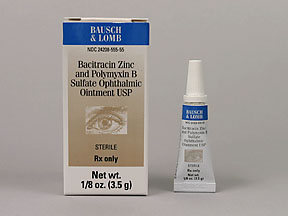
Bacitracin-polymyxin B Coupons & Savings Card – Discount Prices from $13.52
Generic for: Ak-poly-bac, Polysporin, Ra double antibiotic
My prescription
Edit
3.5GM of 500-10000UNIT/GM, Bacitracin-polymyxin B (1 Tube)
Select pharmacy

CVS
$19.70
COUPON PRICE
Walgreens
$13.52
COUPON PRICE
Walmart
$13.64
COUPON PRICE
Albertsons
$22.71
COUPON PRICEBacitracin-polymyxin B savings card
Show this card to your pharmacist
Walgreens
$13.52
BIN
ID
PCN
GRP
015995
LHEY759226
GDC
GDRX
Powered by
More prescriptions for eye infection
More prescriptions for eye infection
Price history for Ak-poly-bac (brand) & Bacitracin-polymyxin B (generic)
1 Tube, 3.5GM of 500-10000UNIT/GM
Average retail price for Ak-poly-bac
Average retail price for Bacitracin-polymyxin B
Average SaveHealth price for Bacitracin-polymyxin B
Our price history data is based on aggregated prescription data collected from participating pharmacies in America. Our prescription data updates daily to reflect the latest price changes. If you notice a missing data point, it means there wasn't sufficient data available to generate a monetary value for that date.
We analyzed Bacitracin-polymyxin B prices for (3.5GM of 500-10000UNIT/GM, 1 Tube) over the last 12 months. The average retail price was $55.90, while the average price using the SaveHealth discount card was $19.74. That's a savings of approximately 64.69% when using our Bacitracin-polymyxin B coupon.
Compared to the generic version, Ak-poly-bac had an average price of $27.71 over the same time period. With the SaveHealth savings card, Bacitracin-polymyxin B is 28.76% cheaper on average than Ak-poly-bac.
*Retail prices are based on pharmacy claims data, and may not be accurate when we don't have enough claims.
Bacitracin-polymyxin B dosage forms
Dosage Quantity Price from Per unit 3.5GM of 500-10000UNIT/GM 1 Tube $13.64 $13.64 3.5GM of 500-10000UNIT/GM 2 Tubes $21.40 $10.70 3.5GM of 500-10000UNIT/GM 3 Tubes $23.10 $7.70
| Dosage | Quantity | Price from | Per unit |
|---|---|---|---|
| 3.5GM of 500-10000UNIT/GM | 1 Tube | $13.64 | $13.64 |
| 3.5GM of 500-10000UNIT/GM | 2 Tubes | $21.40 | $10.70 |
| 3.5GM of 500-10000UNIT/GM | 3 Tubes | $23.10 | $7.70 |
Bacitracin-polymyxin B Warnings
The following safety information outlines crucial warnings associated with the use of Ak-Poly-Bac (bacitracin / polymyxin B) eye ointment. Please read these details carefully and discuss any concerns with your healthcare provider.
Delayed Healing: In cases of corneal injury or infection, the application of this eye ointment may impede the healing process. Consult your healthcare provider to determine if this treatment is appropriate for your condition.
Risk of New Infections: Continued use of Ak-Poly-Bac beyond the prescribed duration (typically 7 to 10 days) can lead to new infections from fungi or antibiotic-resistant bacteria. Ensure hygiene by washing hands before and after application and preventing the container tip from touching any surfaces or the eye. Report any signs of a new infection or lack of improvement in original symptoms to your healthcare provider promptly.
Allergic Reactions: While mild irritation is common, notify your provider if you experience significant itching, redness, or swelling of the eyes or eyelids, as these could be signs of an allergic reaction to the medication. If you have a history of allergies to antibiotics like gentamicin, seek advice from your healthcare provider or pharmacist before using Ak-Poly-Bac.
Make sure to adhere to these guidelines to ensure safe and effective use of the medication.
Bacitracin-polymyxin B Side Effects
Common side effects:
- burning
- redness
- irritation of the skin
Less common but important to monitor:
- itching
- swelling
- redness (potential allergic reaction)
Serious side effects:
- balance or hearing problems
- small red bumps on the skin (folliculitis)
- eye-related issues (pain, redness, irritation, discharge)
- fungal infection
- bacterial skin infection
- scaling
- swelling (unusual skin symptom)
- hot skin
- very serious allergic reaction (rash, severe itching or swelling of the face, lips, tongue, or throat, severe dizziness, breathing difficulties)
Bacitracin-polymyxin B Interactions
Bacitracin and Polymyxin B are antibiotics commonly combined in topical ointments to prevent infections in minor cuts, scrapes, or burns. When applied to the skin, these medications are generally safe and have minimal interactions with other drugs. However, if either antibiotic is administered systemically (through injection), there is a potential for interactions with other medications.
Systemic use of polymyxin B can increase the risk of kidney and nerve damage, especially when used with other drugs that have similar side effects. These include certain antibiotics like bacitracin, aminoglycosides (e.g., gentamicin, Tobramycin), and Vancomycin, as well as medications such as Cisplatin and Furosemide. Combining these drugs may heighten the likelihood of adverse effects.
Additionally, polymyxin B can interfere with muscle relaxants used during anesthesia, potentially leading to serious complications. Therefore, it's crucial to inform your healthcare provider about all medications you're taking before undergoing any surgical procedures.
It's important to note that these interactions are primarily a concern with systemic use of bacitracin and polymyxin B. When used topically as directed, these antibiotics are unlikely to interact with other medications. Always follow your healthcare provider's instructions and consult them if you have any concerns about potential drug interactions.
